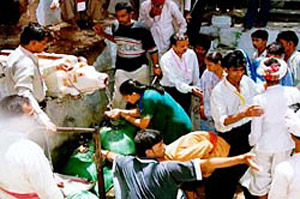Mount Abu is the only hill station in Rajasthan. The history of this mountainous region is steeped in mythology. Once upon a time it was part of the Chauhan kingdom. They treated Mount Abu as a summer retreat. Even for later Rajput rulers this picturesque place served the same purpose. During the British rule the Mount Abu was lent to Maharaja of Sirohi as the headquarters of the resident of the Rajputs.
For the British Mount Abu was their favorite summer destination. For them it was a welcome respite from the dusty and dry heat of India. it also served as a sanatorium for the British troops. Even today the small huts and cottages in Mount Abu stand testimony to this fact. According to legends Mount Abu was the abode to several saints and sages.
 It is a popular belief that all the gods and goddesses of Hindu pantheon used to visit this sacred mountain. It was also the place where the Hindu hermit Vashishth resided and performed yagna to form four Agniukula or four clans of fire. It was done to protect the earth from demons. It was performed at the site of the present Gaumukh temple.
It is a popular belief that all the gods and goddesses of Hindu pantheon used to visit this sacred mountain. It was also the place where the Hindu hermit Vashishth resided and performed yagna to form four Agniukula or four clans of fire. It was done to protect the earth from demons. It was performed at the site of the present Gaumukh temple.
Another legend related to sage Vashishth`s cow is also popular in the hills of Mount Abu. The cow named Nandini was trapped in a deep gorge and could not come out of it. The hermit appealed for help to Lord Shiva. Goddess Saraswati was sent by the lord for help. The goddess in the form of stream flooded the gorge and this enabled the cow to float to the surface. Taking a cue from such an incident Vashishth muni asked his son Himalaya to fill the gorge permanently so that such unpleasant incidents are not repeated.
This task was completed by Himalaya with the help of Arbud, the mighty snake. From then on the place came to be known as Mount Arbud. In the later years the name was changed to Mount Abu.
Besides the Hindus Mount Abu is also important historically for the Jains. According to Jain scriptures Lord Mahavira had visited the city. As a result a number of Jain temples are to be found here.



















